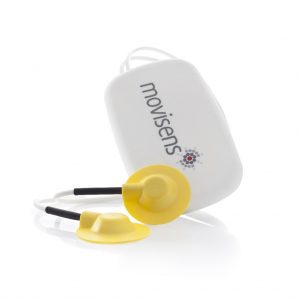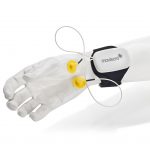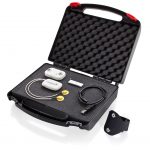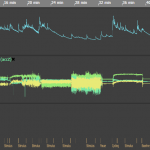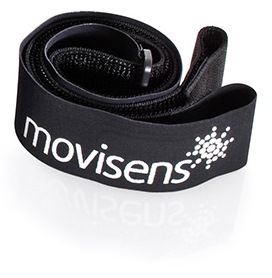edaMove – EDA and Activity Sensor
The edaMove is a psycho physiologic ambulatory measurement system that can detect and measure Electro-dermal Activity (also known as Galvanic Skin Response).
The sensor acquires the raw data of the EDA and the 3D acceleration of a subject for up to 2 weeks. From this data secondary parameters like skin conductance level (SCL), skin conductance responses (SCR), and activity intensity can be calculated with the movisens DataAnalyzer software.
Containing the precise 3D acceleration capture technology that comes in all of our sensors, the edaMove is optimized for research applications. The ability to capture motion, barometric pressure and temperature allows a more precise analysis of the data. These parameters allow the clear identification of measurement artefacts that normally hinder the assessment of EDA data in an ambulatory setting.
The sensor is worn with a wristband and comes with multi-use sintered electrodes.
Apply for free student project
Top features
- Complies with all relevant EDA-standards
- Perfect signal quality in everyday life
- Includes 3D acceleration sensor for the acquisition of physical activity and context information
- Sustainable data due to open file format
- Operation optimized for studies
- Open interfaces: SDK for Bluetooth and USB
Applications
- Mobile long-term monitoring of EDA (elecrodermal activity) / GSR (galvanic skin resonse)
- Psycho physiologic monitoring
- Research of the autonomic nervous system (ANS)
- Behavioral monitoring
- Industrial psychology
- Clinical psychology
- Affective computing
- Integration into complex systems possible
Matching Products and services
Downloads
| Software |
|
|---|---|
| Documentation |
|
| Data examples |
|
| External Tools |
Technical data
|
Power supply |
Lithium-Ion battery |
|
Supply voltage |
3 V |
|
Accumulator voltage |
2.7 – 4.2 V |
|
Number of charging cycles |
300 with 1C/1C > 80% |
|
Maximum recording capacity |
~ 2 weeks, depending on manufacturer configuration |
|
Battery run time (recording, Bluetooth off) |
~ 1,5 days |
|
Size of sensor (W x H x D ) |
62.3mm x 38.6mm x 10.5mm |
|
Weight of sensor |
26,2 g |
|
Internal sensors |
EDA / GSR amplifier: Exosomatic method, DC, 0.5V Resolution 14bit, Input range 2µS up to100µS Bandwith: DC to 8Hz Output rate: 32Hz
3D acceleration sensor: Measurement range: +/- 8 g Noise: 4 mg Output rate: 64 Hz
Pressure sensor: Measurement range: 300 - 1100 hPa Noise: 0.03 hPa Output rate: 1 Hz |
|
Indicators |
LED, 3-color (operation and charging status) Vibrating alert (start and end of measurement) |
|
Interfaces |
Micro-USB, Bluetooth |
|
Environmental conditions |
Temperature: -20 °C to 60 °C 0 °C to 45 °C during charging
Humidity: 0 to 75% RH relative humidity
Atmospheric pressure: 300 to 1100 hPa absolute |
Literature
- A Comparison between Laboratory and Wearable Sensors in the Context of Physiological Synchrony.
- Moments That Matter? On the Complexity of Using Triggers Based on Skin Conductance to Sample Arousing Events Within an Experience Sampling Framework..
- Evaluating Usability Aspects of a Mixed Reality Solution for Immersive Analytics in Industry 4.0 Scenarios.
- Social anxiety is associated with heart rate but not gaze behavior in a real social interaction..
- Measuring Behavior 2020-21.
- Physiological synchrony in EEG, electrodermal activity and heart
rate reflects shared selective auditory attention. - Applicability of Immersive Analytics in Mixed Reality: Usability Study.
- Electrodermal activity patterns in sleep stages and their utility for sleep versus wake classification.
- A mixed-methods study of physiological reactivity to domain-specific problem solving: methodological perspectives for process-accompanying research in VET.
- Estudo piloto em câmara climática: efeito da luz natural em aspectos de saúde e bem-estar não relacionados à visão.
- Detecting cognitive underload in train driving: A physiological approach.
- Mobile Sensors for Multiparametric Monitoring in Epileptic Patients.
- A personalized and reconfigurable cyberphysical system to handle multi-parametric data acquisition and analysis for mobile monitoring of epileptic patients.
- Evaluation of environmental effects on the measurement of electrodermal activity under real-life conditions.
- Komfortgewinn für Passagiere auf Langstreckenflügen durch den Einsatz chronobiologisch angepasster LED-Kabinenbeleuchtung.
- Publication recommendations for electrodermal measurements.
You can find more publications here.
